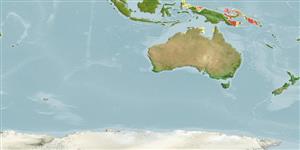>
Gobiiformes (Gobies) >
Gobiidae (Gobies) > Gobiinae
Etymology: Eviota: No etymology given, suggested by Christopher Scharpt: from Latin 'eu' for 'true' and 'iota' for anything very small, in combination 'truly very small' referring to it as being the smallest vertebrate at the time it has benn described by Jenkins (thus, making the suggestion by Scharpt plausible; dorsopurpurea: Name from Latin 'dorsum' for back and 'purpura' for purple; referring to the purple color of the back above the lateral line.
More on authors: Greenfield & Randall.
Environment: milieu / Zona climática / intervalo de profundidade / distribution range
Ecologia
marinhas associadas(os) a recifes; intervalo de profundidade 8 - 30 m (Ref. 90102). Tropical
Western Pacific: Papua New Guinea.
Tamanho / Peso / Idade
Maturidade: Lm ? range ? - ? cm
Max length : 1.7 cm SL macho/indeterminado; (Ref. 87726); 2.2 cm SL (female)
Descrição suscinta
Chaves de identificação | Morfologia | Morfometria
Espinhos dorsais (total) : 7; Raios dorsais (total) : 8 - 9; Espinhos anais: 1; Raios anais : 7 - 9. This species is distinguished from its congeners by the following set of characters: a dark band on lower body from snout, across the lower half of the eye back to the caudal-fin base ending in a semi-circle; larger specimens with pectoral-fin base having a reversed L-shaped row of small black dots; cephalic sensory pore system lacking the PITO and IT pores and the AITO pore enlarged; dorsal/anal fin-ray formula usually 9/9; pectoral-fin rays simple; spinous dorsal elongate or filamentous in both sexes; genital papilla nonfimbriate; in life ventral band jet black, and with purple upper half of body and top of head (Ref. 87726); characterized further by having ctenoid scales, none on head, nape and pectoral fin base; separated pelvic fins, thin membrane joins bases; depth of body 4.1-5.6 in SL (Ref. 90102).
Body shape (shape guide): elongated; Cross section: oval.
Forms groups among branches of Acopora coral, inhabits sheltered reefs in 8-30 m (Ref 90102).
Ciclo de vida ou comportamento de acasalamento
Maturidade | Reprodução | Desova | Ovos | Fecundidade | Larvas
Greenfield, D.W. and J.E. Randall, 2011. Two new Indo-Pacific species in the Eviota nigriventris complex (Teleostei: Gobiidae). Zootaxa 2997:54-66. (Ref. 87726)
Status na Lista Vermelha da UICN (Ref. 130435: Version 2025-1)
Ameaça para os humanos
Harmless
Uso pelos humanos
Ferramentas
Relatórios especiais
Baixar XML
Fontes da internet
Estimates based on models
Preferred temperature (Ref.
123201): 27 - 29, mean 28 °C (based on 68 cells).
Índice de diversidade filogenética (Ref.
82804): PD
50 = 0.5000 [Uniqueness, from 0.5 = low to 2.0 = high].
Bayesian length-weight: a=0.00692 (0.00284 - 0.01683), b=3.10 (2.92 - 3.28), in cm total length, based on LWR estimates for this Genus-body shape (Ref.
93245).
Nível Trófico (Ref.
69278): 3.1 ±0.3 se; based on size and trophs of closest relatives
Fishing Vulnerability (Ref.
59153): Low vulnerability (10 of 100).
🛈
